#my research
Text
Over the last few years, I’ve begun to heavily encourage people to think of a zoo or aquarium or sanctuary being accredited as conveying important information about their ethos / operations / politics - but not as an inherent indicator of quality. Why? Because accrediting groups can be and are fallible. There are issues with all of the accrediting groups and programs, to varying degrees, and so they’re just a piece of information for a discerning zoo-goer to incorporate into their overall opinion. I just saw a news article go by with some data that proves my point.

First off, good for Houston, no commentary that follows is directed that them.
This isn’t the first time I’ve seen a headline like this - there was one a couple years ago, about Cheyenne Mountain Zoo in Colorado also getting a perfect inspection. But here’s what bugs me about it.
If you see/hear the phrase “Facility X has been accredited by Y organization, which holds the highest standards in the world for this type of facility”, it kind of implies that facility X meets all of those standards, doesn’t it? Not most of them, not the majority. When you hear that a zoological facility has gone through a rigorous process to earn an accreditation branded (by the accrediting org) as “the gold standard” in the industry… the general public is going to interpret that as saying these facilities are in compliance with every single rule or standard. And what these headlines tell us, alongside the commentary from AZA in the articles, is that it’s not only not true - it never has been true. Most AZA accredited facilities apparently don’t meet all the AZA standards when they’re inspected, and that’s both okay with them and normal enough to talk about without worrying about the optics.
Let’s start with the basic information in the Houston Chronicle article, which will have been provided to them by the zoo and the AZA.
“Since it's inception in 1974, the AZA has conducted more than 2,700 inspections and awarded only eight perfect evaluations throughout the process's 50-year history. Houston Zoo's final report is 26 pages long — and filled with A's and A-pluses."
Okay, so… doing that math, less than one percent of AZA accreditation inspections don’t meet all the standards at the time of inspection. But, wait, that’s not just what that says. That bit of information isn’t talk about AZA accredited facilities vs the ones that got denied accreditation: this is telling us that of facilities that earned AZA accreditation, basically none of them meet all the standards at the time. This isn’t talking about tabled accreditations or provisional ones where they come back and check that something improved. Given that math from earlier, this information means that most - if not all - AZA accredited facilities have repeatedly failed to meet all of the standards at one point in time … and have still been accredited anyway.
That tracks with what was said about Cheyenne Mountain Zoo, back in 2021 when they got their perfect accreditation.
“Cheyenne Mountain Zoo has earned an incredibly rare clean report of inspection and its seventh consecutive five-year accreditation from the Association of Zoos and Aquariums (AZA). In nearly 50 years of accreditations, CMZoo is only the fourth organization to earn a ‘clean’ report, which means there wasn’t a single major or minor concern reported”
Seven consecutive accreditation processes - and only one of them where they actually met all the standard at the time.
Here’s what the AZA CEO had to say about Houston’s accreditation achievement in that article, which reinforces my conclusion here:
"AZA president and CEO Dan Ashe says the multi-day inspection process, which occurs every five years, has been described as "comprehensive, exhausting and intimidating."
"We send a team of experts in who spend several days talking to employees, guests and the governing board. They look at animal care and husbandry. They look at the governance structure and finances. They look comprehensively at the organization," Ashe explains. "For a facility like Houston Zoo to have a completely clean accreditation and inspection is extremely rare. These inspectors are experts, it's hard to get to the point where they can't find something.""
Now, here’s the rub. We, as members of the public, will never have any idea which standards it is deemed okay for a given AZA facility to not meet. All of the zoological accrediting groups consider accreditation information proprietary - the only way we find out information about how a facility does during accreditation is if they choose to share it themselves.
On top of that, it’s complicated by the fact that last time I read them AZA had over 212 pages of accreditation standards and related guidance that facilities had to comply with. Now, AZA doesn’t accredit facilities if there are major deviations from their standards, or if there’s an issue on something important or highly contentious. So - based on my completely outsider but heavily researched perspective - this probably means that most zoos are in non-compliance with a couple of standards, but not more than a handful.
To make trying to figure this out even more fun, it is also important to know that AZA’s standards are performance standards: whether or not they’re “met” is based on a subjective assessment performed by the accreditation inspectors and the accreditation committee. This means that what qualifies as fulfilling the standards can and does vary between facilities, depending on who inspected them and the composition of the committee at the time.
So why do I care so much? Because when it comes to public trust, branding matters. AZA has gained a reputation as the most stringent accrediting group in the country - to the point that it can lobby legislators to write exceptions into state and federal laws just for its members - based on how they message about their accreditation program. How intensive it is, how much oversight it provides, what a high level of rigor the facilities are held to. That… doesn’t track with “well, actually, the vast majority of the zoos meet most of the standards most of the time.” People who support AZA - people who visit AZA accredited zoos specifically because of what it means about the quality of the facility - believe that accreditation means all the standards are being met!
To be clear: most AZA zoos do meet some pretty high standards. It’s likely that what are being let slide are pretty minor things. I expect it’s on stuff the facility can improve without too much hassle, and it might be that doing so is probably part of what’s required. There’s not enough information available to people outside the fold. But I will say, I don’t think any zoo is getting accredited despite AZA having knowledge of a serious problem.
Where I take issue with this whole situations is the ethics of the marketing and branding. AZA frames themselves as being the best-of-the-best, the gold standard, when it turns out that most of their accredited zoos aren’t totally in compliance, and they know and it’s fine. They seem to be approaching accreditation like a grade, where anything over a certain amount of compliance is acceptable. The public, though, is being fed a narrative that implies it’s a 99/100 pass/fail type of situation. That’s not super honest, imho, which shows up in how there’s zero transparency with the public about it - it goes unspoken and unacknowledged, except when it’s used for promotional gain.
And then, like, on top of the honesty in marketing part, it’s just… something that gets joked about, which really rubs me the wrong way. Like this statement from the media releases for the Cheyenne Mountain accreditation:
“Another of our ‘We Believe’ statements is, ‘We value laughter as good medicine,’” said Chastain. “To put this clean accreditation into perspective, when I asked Dan Ashe, AZA president and CEO, for his comments about how rare this is, he joked, ‘A completely clean inspection report is so unusual, and so unlikely, it brings one word to mind — bribery!’“
So, TL;DR, even AZA accreditation is designed so that their accredited zoos don’t have to - and mostly don’t - actually fully meet all the standards. I’d love to know more about what types of standards AZA is willing to let slide when they accredit a facility, but given the proprietary nature of that information, it’s pretty unlikely there will ever be more information available. AZA accreditation tells you what standards a zoo aspires to meet, what their approximate ethics are, and what political pool they play in. When it comes to the quality of a facility and their animal care, though, sporting an accreditation acronym is just a piece of the larger puzzle.
#AZA accreditation#zoo accreditation#zoo politics#my research#There’s a lot more nuance to how accreditation inspections work and how facilities with bigger issues are given changes to correct them#but that’s for another post#right now I’m just irked that it is so normative for AZA facilities to get accredited without clean inspections
460 notes
·
View notes
Text

whoops
260 notes
·
View notes
Text


If you’re looking at this, you are one of the first in the world to see the brain cells of the Australian stingless bee (Tetragonula carbonaria).
I’ve been learning the isotropic fractionator method to count brain cells in the brain. The plan is to apply this method to Australian bee species to find out the number of neurons in their brains.
1K notes
·
View notes
Text
Les Misérables summarized, but I include all the typos that I have found in articles published between 1862 and 1978

#les miserables#lm pour rire#my research#not really my research but the byproduct of it#everytime I find a typo I save it to a folder
1K notes
·
View notes
Note
as someone with a passing knowledge of knot theory & a dilettante interest in math I'm really interested in the behavior/rules of those graphs, could you talk a little more about them?
this is my first ask! and it's on my research!!! i still do research in this area. i am getting my phd in topological quantum computation. i saw someone else talk about categorical quantum in response to the post. as i understand, this is a related but distinct field from quantum algebra, despite both using monoidal categories as a central focus.
if you're familiar with knot theory, you may have heard of the jones polynomial. jones is famous for many things, but one of which is his major contributions to the use of skein theory (this graphical calculus) in quantum algebra, subfactor theory, and more.
For an reu, i made an animation of how these diagrams, mostly for monoidal categories, work:
https://people.math.osu.edu/penneys.2/Synoptic.mp4
to add onto the video, in quantum algebra, we deal a lot with tensor categories, where the morphisms between any two objects form a vector space. in particular, since these diagrams are representing morphisms, it makes sense to take linear combinations, which is what we saw in the post. moreover, any relationships you have between morphisms in a tensor category, can be captured in these diagrams...for example, in the fusion category Fib, the following rules apply (in fact, these rules uniquely describe Fib):

thus, any time, these show up in your diagrams, you can replace them with something else. in general, this is a lot easier to read than commutative diagrams.
60 notes
·
View notes
Text
I may have to go to a PhD program in Tennessee in order to continue work that I actually want to do.
#I hate it#i hate being forced to choose between being trans and#my research#Both of which I find to be essential parts of my life and identity
22 notes
·
View notes
Photo
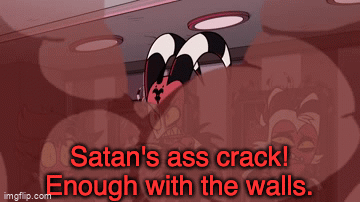
Poor Blitz, losing his “research” and wall all in the same day. :( Although I think I still feel worse for the children that are now traumatized by said “research.” XD
#helluva boss#vivziepop#blitz#blitzo#moxxie#millie#moxxie and millie#exes and oohs#gif#my research#helluva boss blitz#helluva boss blitzo#helluva boss moxxie#helluva boss millie#XD#funny#the trauma is real
94 notes
·
View notes
Text
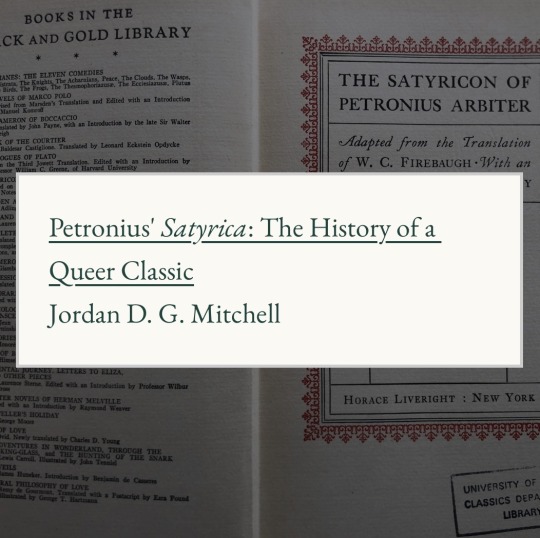
I wrote a piece for Ekklesia — The Online Classics and Ancient History Magazine on how Petronius’ Satyrica has been something of a queer* icon over the past 350 years.
*queer here meaning Petronius was claimed by so-called “deviant” communities, social or sexual, in order to mark themselves as a member of such a community.
29 notes
·
View notes
Text
Rating the Nonsense* I found doing queer historiography research
back in 2020 I was doing a project on queer historiography prior to the queer liberation movement. Since I needed a bunch of sources, my four criteria were:
had to be accessible online (early days of the pandemic)
had to be in English
had to have been identified by another researcher or archive as queer (because i didn't have time to make arguments for every single piece of evidence)
had to be from before 1969
so, as you can imagine, I found some wild stuff. I put this together for a powerpoint party last year and now I am sharing it with the world. enjoy. includes some nsfw text.
THREE CRITERIA RATING SCALE:
"Just Saying Shit" aka wow you didn't have to cite your sources at all did you
"Sure?" aka I'll go ahead and integrate that into my belief system
"Creativity" aka this FUCKS
*all of this nonsense is from the non-fiction. we're not getting into the Victorian 'girdle of cunts' gangbang erotica.

EXHIBIT 1: "The Chimp," ONE Magazine, 1954. Part of a series of cartoons satirizing gay bar attendees. Ink cartoon of a chimpanzee wearing glasses sitting on a chair, martini glass held by prehensile toes. One hand is holding a cigarette and the other hand is gesturing. Caption reads "For instance, in ancient Greece, it was considered the highest form of..."
Just Saying Shit: 2/10 I fully believe the artist absolutely knew a bunch of people like this, try harder. We are just getting started.
Sure?: 2/10 they just don't make 'em like this anymore
Creativity: 8/10 haha fursonas in the 50s

EXHIBIT 2: Gordon Rattray Taylor, part 1. Book quote reading "According to some accounts, the Devil is equipped with a forked penis so that he can commit both buggery and fornication at the same time."
there was a book about ‘the multiple roots of homosexuality’ and if I did the whole thing we’d be here all day. This guy wrote a chapter.
Just Saying Shit: 4/10, he’s quoting other sources but props for making it sound like it’s a factual thing about the Devil as a real person who exists. An extra point for not actually citing these sources.
Sure?: 7/10 I hear hemipenes are a kink according to the scalies
Creativity: 1/10 for Rattray Taylor who was quoting this but 9/10 for the original postulators.
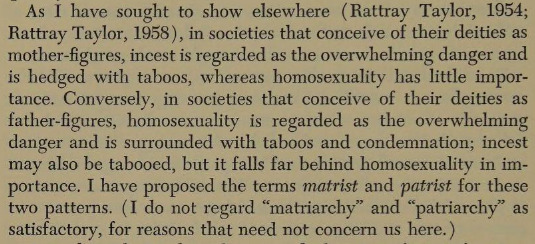
EXHIBIT 3: Gordon Rattray Taylor, part 2. Book quote reading "As I have sought to show elsewhere (Rattray Taylor, 1954; Rattray Taylor, 1958), in societies that conceive of their deities as mother-figures, incest is regarded as the overwhelming danger and is hedged with taboos, whereas homosexuality has little importance. Conversely, in societies that conceive of their deities as father-figures, homosexuality is regarded as the overwhelming danger and is surrounded with taboos and condemnation; incest may also be tabooed but it falls far behind homosexuality in importance. I have proposed the terms matrist and patrist for those too patterns. (I do not regard "matriarchy" and "patriarchy" as satisfactory, for reasons that need not concern us here.)
Just Saying Shit: 8/10 now THAT’S what I’m talking about!! Hit me with your nonsense theories. Classic anthropology right here.
Sure?: 3/10 I will regurgitate this occasionally but only because it’s kind of funny
Creativity: 2/10 you did it! You broke gender essentialism down to its bare essentials and added gods!

EXHIBIT 4: Gordon Rattray Taylor, part 3. Book quote reading "The Acta Sanctorum includes accounts of "Brother Marinos," whom the other monks supposed to be a eunuch from his voice and beardlessness, who was even accused of seducing a local girl, and who turned out at death to be female; of frater Pelagius monachus et eunuchus, also a girl; of Marina, Margarita, and others. Other Instances noted by Delcourt (1961) include Athanasia of Antioch, Eugenia of Alexandria, Apollinaria, Papula of Gaul, and Hildegonde of Neuss."
Honestly i just put this one in here because it’s neat. Trans* rights.
Just Saying Shit: 0/10 you have actually clearly named your sources for once
Sure?: 10/10 hey can we talk about ‘eunuch’ as not only a codified transgressive gender role but also as the rare gender&sexuality thing we can clearly translate across multiple societies–
Creativity: 5/10 for not just stopping with Joan of Arc like 90% of ‘cross-dressing in the church!’ stuff
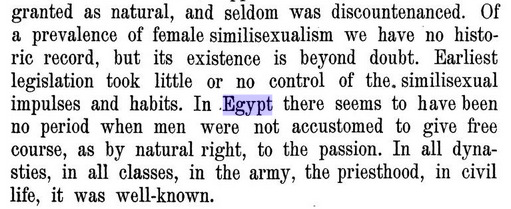
EXAMPLE 5: Edward Prime-Stevenson, part 1. Book quote reading "Of a prevalence of female similisexualism we have no historic record, but its existence is beyond doubt. Earliest legislation took little or no control of the similisexual impulses and habits. In Egypt there seems to have been no period when men were not accustomed to give free course, as by natural right, to the passion. In all dynasties, in all classes, in the army, the priesthood, in civil life, it was well-known."
Love this bastard. He wrote a 600 page book all by his damn self in 1911 and cited absolutely nothing.
Just Saying Shit: 9/10 THIS is what we’re here for. All of Egypt was gay Because I Say So
Sure?: 8/10 I will believe this as a treat for me
Creativity: 4/10 this fucks but points off for using it to argue the Torah is homophobic

EXAMPLE 6: Edward Prime-Stevenson, part 2. Book quote reading "The "Sexual Germ" in Friendships. Meantime, however displeasing to the reader, let it be affirmed that all real friendships between men have a sexual germ."
BEHOLD MY MOST ABSOLUTE FAVORITE QUOTE I PUT IN MY THESIS
Just Saying Shit: 12/10 absolute madlad fucking love it
Sure?: 5/10 torn between ‘I want to believe’ and ‘dude i think that might just be you’
Creativity: 7/10 because I love it. The shippers were right.

EXAMPLE 7: Edward Prime-Stevenson, part 3. Book quote reading "Socrates was similsexual. Not readily can we dismiss the idea that Christ was such--and saints may have been Uranians."
Just Saying Shit: 9/10. Look at him go. Elaborate on that??? (P-S: no.) (that’s a lie he goes on other places to explain his ship manifesto for Christ and John the Baptist) (CATHOLICS IN THE AUDIENCE DO NOT @ ME I KNOW THEY'RE COUSINS. ARGUE WITH THE DEAD GUY.)
Sure?: 9/10 we’ve all seen Jesus Christ Superstar (1973)
Creativity: 3/10 again. we’ve all seen Jesus Christ Superstar (1973)
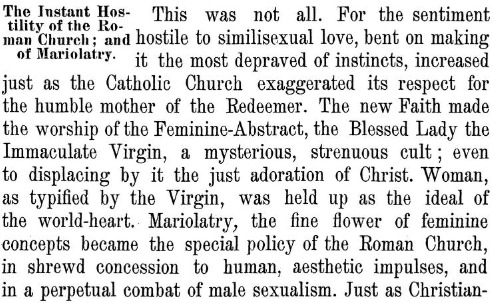

EXAMPLE 8: Edward Prime-Stevenson, part 4. Book quote reading "The Instant Hostility of the Roman Church; and of Mariolatry. This was not all. For the sentiment hostile to similisexual love, bent on making it the most depraved of instincts, increased just as the Catholic Church exaggerated its respect for the humble mother of the Redeemer. The new Faith made the worship of the Feminine-Abstract, the Blessed Lady the Immaculate Version, a mysterious, strenuous cult; even to displacing by it the just adoration of Christ. Woman, as typified by the Virgin, was held up as the ideal of the world-heart. Mariolatry, the fine flower of feminine concepts became the special policy of the Roman Church, in shrewd concession to human, aesthetic impulses, and in a perpetual combat of male sexualism. Just as Christianity had darkened existence with the gloom and gore of the cross, so the sentiment of Mary worship was to effeminize the social and sexual life of the male."
Was I just supposed to leave out him calling the entire Roman Catholic Church emasculated.
Just Saying Shit: 7/10 because he thinks he’s making a reasonable argument here
Sure?: 4/10 my dude did you try to seduce a guy only for him to wax eloquent about the Virgin Mary
Creativity: 2/10 I feel like this is just misogyny. Sorry people aren’t making religious statues of who you find hot

EXAMPLE 9: Walt Whitman's Anomaly--WC Rivers. Book quote reading "What really attracted him about manual labour was the picturesque male images it called up. "To be lean'd and to lean on," is quite an unfatiguing use of the seven-pound felling axe. Then there is his robust aspect. President Lincoln's exclamation on first seeing him-- "Well, he looks like a MAN!" --is much quoted by biographers."
Love this pamphlet. Just a dude in the 1910s going ‘I think Whitman was gay!’ with genuine delight and surprise. He a little confused but he got the spirit.
Just Saying Shit: 4/10 this is a very well documented quote but what a way to use it
Sure?: 12/10 HEY ABE?? HEY ABE LINCOLN?? THIS IS UP THERE AS ONE OF THE GAYEST THINGS YOU EVER SAID
Creativity: 7/10 for the circumstances in which this quote was employed namely in a chapter about possible objections to Whitman being gay
FINAL TALLY
-God I love history
-why can’t I Just Say Shit
-Go read Shel Silverstein’s Fire Island Playboy cartoons
#queer history#historyish#my research#i don't think i have a tag. uhhhh#thesis or death#there's some other stuff in there
96 notes
·
View notes
Text
when i present a linguistic analysis of sunny at a professional research conference
#iasip#it’s always sunny in philadelphia#it’s always sunny in philly#research#my research#conference#linguistics
16 notes
·
View notes
Text



Statues of Hannibal Barca (Slodtz, 1704) and Julius Caesar (Slodtz, 1713) at Le Louvre, Paris, France
I love how they put these two statues next to each other, Hannibal gloating about his victory over Rome and Caesar in a dramatic, commanding pose. Even if there was quite a stretch of time between the two, I like to think these two great generals of two rival nations are symbolically duking it out in perpetuity.
(Photos taken by me. 2023)
7 notes
·
View notes
Text
Y'all regularly send in questions wanting to know how to report concerns you've observed at zoos you've visited. I've been able to point people at the USDA (regulatory) option, but with regard to accrediting groups I haven't had a good answer. I spent the last six months or so really digging into why there hasn't been a good answer. What I've found is that the majority of zoological accrediting groups in the United States don't provide any way for the public to report issues they've observed at accredited facilities, and none of said organizations have a mechanism for truly supporting / protecting staff who might choose to report issues at their own facilities. Which is. not great.
I wrote a whole Substack post about it a few days ago, arguing that in order to remain credible institutions accrediting groups must facilitate public reporting, anonymous reporting, and commit to enforcing penalties for any retaliation against staff who choose to utilize the option. I'm linking it below for anyone who is interested in all the details. CW at the beginning for animal abuse mentions - I started the piece by discussing a truly egregious welfare situation that occurred last year at a Miami facility, which might have been prevented or at least caught earlier if the two groups that accredit the facility had had a reporting mechanism in place.
What I want to talk about here, though, is specifically why accrediting orgs need to not only have an anonymous reporting option for staff, but why they must ban retaliation and penalize any facility that does it anyway. Whenever something terrible happens at a zoo or sanctuary, people always ask "why didn't the staff say something?" And the answer is, basically, because taking that risk can get you not just fired, but blacklisted from the field. People literally end up having to choose between their careers and making noise about issues that aren't being resolved, and that's absolutely not freaking okay. But I want to explain for you the extent of the issue.
If you're not industry, something you might be surprised to learn is that most zoo staff don't have any special reporting options above and beyond what the public does. Most zookeepers and other low-level staff never interact with people from accrediting groups except during an actual inspection - so if there's a problem, it's not like they know someone they can back-channel a concern to if they don't feel safe reporting it publicly. And for the most part, reporting things your facility is doing to an accrediting group will always be considered inappropriate and probably get a keeper in trouble (even if it's a really valid issue).
The zoological industry runs on a strongly hierarchical system. Staff are expected to “stay within their lanes” and work within the established bureaucracy to resolve issues. Deviating from this, if staff feel like management are suppressing issues or something needs to be addressed urgently, is very heavily frowned upon. Basically, going around management to bring something to an accrediting group (or USDA, or the media) is seen as indicating that your facility has failed to address a problem, or that the individual making the report feels they know more than their superiors. At most places, no matter how extreme an issue may become, there's never a point at which it would be acceptable for a staff member to reveal a facility’s internal issues to their accrediting body.
The thing is, attempting to resolve issues through the proper internal channels at a facility doesn't always work! It can result in an issue being covered up (especially if the company is kinda shady) or suppressed rather than addressed. If staff decide to push the issue, it can really backfire and jeopardize their job, because it's expected that if management says something is fine, staff need to acquiesce and go along with it.
There have been a couple high-profile examples of this in the last decade: the incident I mention in my Substack where new management at the Miami Seaquarium decided to starve dolphins to coerce them into participating in guest programs, and an issue at the Austin Zoo five-ish years ago where the director was perpetuating serious welfare issues and ignoring staff feedback. In both cases, there's always the questions of where the accrediting group was. We don't know anything about what happened with the Seaquarium (it's been over six months since the USDA report documenting the diet cuts was released and AMMPA and American Humane haven't said a thing), but I remember hearing that ZAA had no idea what was happening at Austin because nobody had reached out to them about it.
This is why I'm arguing that all zoological accrediting groups need to make visible reporting options and make sure staff feel safe enough to use them! If you've got a facility perpetuating or not dealing with major issues, it's pretty probable that they're going to be unhappy if their staff reports those issues to any oversight body. That's not a situation where it's currently safe to speak up right now - and four out of five zoological accrediting groups in the US don't have standards prohibiting retaliation against staff for bringing up issues like that! (Surprisingly, it's not AZA. It's the sanctuary accrediting group, GFAS). Without any option for internal reporting, issues may not get addressed - which hurts animal welfare - or people risk losing their job, possibly their entire career in the field (which is a huge part of people's identities!), and their financial stability to advocate for their animals.
Currently, the two accrediting groups that do have reporting options (AZA and GFAS) stay they'll attempt to keep reports anonymous, but acknowledge it may not be possible to do so. (Which tracks, because zoo jobs are highly specialized and only a few people may be exposed to an issue). However, only GFAS prohibits facilities from retaliating against people who make reports. On top of that, there's absolutely no transparency about what happens next: GFAS, ZAA, AMMPA and AH have no information about how the process transpires and if someone making a report will get any information back about what happened. AZA straight up says that all accreditation stuff is proprietary (read: confidential) so you just have to trust that they dealt with it appropriately. Just yeet your report into the void and hope the groups doing oversight handle it correctly when there's no accountability? That's... not a great look for animal welfare concerns.
I hope the industry chooses to fix this problem. I hope it chooses to invest in transparency and increased credibility. I don't know what I expect, but I'd like to see these accrediting groups do the right thing.
My full write-up on how accrediting groups in the US handle reporting and concerns (or don't) is linked below.
2K notes
·
View notes
Text
Few subjects can be quite so boring as history badly written or badly taught; no branch is more open to this than military history.
A few people seem able to derive a satisfaction from studying the moves and deployments of armies without concern for the men who made and undertook them. While often wishing that I could find a little interest in such matters, I must admit that nothing sends me to sleep quicker than bald statements about the so-and-so division advancing along a certain axis, and passing through endless places which are rarely shown on any map.
My concern is always to discover what the men taking part in the operation thought of it.
John Baynes - Morale, a Study of Men and Courage: The Second Scottish Rifles and the Battle of Neuve Chapelle, 1915.
614 notes
·
View notes
Text


These photos show the size difference between Aussie native stingless bees (Tetragonula carbonaria) and the average honeybee (Apis mellifera).
Despite being so tiny this little stingless bee worker was trying to steal the pollen straight from the pollen baskets of the poor honey bee.
257 notes
·
View notes
Text
The difficulty of disliking Les Misérables when the year is 1862 and all your friends are fans
In this post, I want to explore a particular dimension to the politics involved in reviewing Les Misérables in 1862, through the writings of Horace de Lagardie.
“Horace de Lagardie,” according to the 1884 book Les Pseudonymes du jour, was the pen name of one Madame de Peyronnet. Although there is some confusion over her identity (see here), I am fairly certain that the woman in question is Georgina Frances de Peyronnet (née Whitfield), a British journalist who lived and worked in France. Her father owned a slave plantation in the West Indies and she married a French count of little importance (it is believed that she was the author of the translations published under his name). She wrote a column called the Revue du Mois in Charpentier’s Revue nationale et étrangère. She also published a collection of those articles under the title Causeries parisiennes (Parisienne chit-chat).
Lagardie disliked Les Misérables for a number of stylistic and ideological reasons that I won’t get into here (believe me, it would be a long list) but her articles also offer commentary on the constraints she felt on her ability to voice that dislike. In her first article about Fantine, she writes:
The arrival of the two volumes forming the first part of Victor Hugo’s novel, Les Misérables, has proved a useful diversion. All other subjects of conversation pale before this work, around which a unanimous chorus of praise is raised. Today he who would permit himself to utter the most minor discordant note would be very poorly received and the voice of criticism, even in the most respectful form, is rarely heard. To tell the truth, the passionate admiration that is being produced is a bit astounding to the observer who only sees this book as a literary work. It is difficult to understand how people who didn’t admire Notre Dame de Paris or le Dernier Jour d'un Condamné are so enthusiastic about a work that is similar to them in so many ways, both in its beauty and its faults. This cannot be explained either by admiration for its author or by sympathy for his social theories and it is evident that one must take into account the pedestal of exile from which Victor Hugo has not yet descended.
There’s so much to talk about in just that paragraph! First, there’s her assertation that there was a “unanimous chorus of praise” surrounding Les Mis. Despite the fact that there were negative reviews within three days of the publication of Les Misérables, Hugo’s (successful) advertising strategy (which consisted of asking friendly papers to publish praise alongside excerpts of the book) led to the accusation/impression that there was only praise for the book and that those papers were promoting Les Misérables not in support of the book (as a literary or philosophical work) but in opposition to Napoleon III. (This claim had some merit but the full extent to which it is true is not the subject of this post.) The reference to Hugo’s exile was another common talking point in the same vein.
The reason one might praise Les Mis to express one's dislike of Napoleon III is simply because it was not permitted to criticize Napoleon III in a newspaper. To evade censorship, praising Hugo would signal one’s political sympathies. Lagardie notes how adept journalists had become in this form of evasion:
It is certain that the art of saying without speaking and the use of innuendo have made great progress in France, and it is no longer with clarity that the French mind shines today.
Besides those who wrote disingenuous positive reviews of Les Misérables, there was a sizeable contingent of people who opted to say nothing at all rather than criticize Hugo. But only a few journalists who (ostensibly) shared (some) of Hugo's political views, Lagardie among them, opted to criticize his newest work.
Lagardie observed that:
As soon as the work was published, and following the publishers' preliminary advertisements, we saw first articles by friends who praised universally and en bloc; then came the real critics, then finally the detractors, personal enemies or intolerant adversaries.
But Lagardie positions herself as none of the above, stating: “I think the time has come to state my opinion [on the first volume]. I think it's essentially the opinion of many people who are not as well placed as I am to express it frankly.”
Although I agree with basically nothing she has to say about the contents of the book, it is interesting to note that she was one of the few women positioned to have her opinion published. Maybe her relative anonymity is what gave her the freedom to express her dissent?
(Side note: it’s possible that Hugo read Lagardie’s review of Fantine. Lacroix definitely did and mentions it to Hugo among a list of negative reviews. “So much the better!” he wrote. “A controversy around Les Misérables is excellent. It's the consecration of success and proof of the work's strength.”)
In Lagardie’s review of Cosette and Marius (released simultaneously a month after Fantine), she wonders whether she should continue to publish her negative review since there are so many positive reviews from the journalists in her sphere:
I am beset by doubt over my own competence. Can I be correct, opposed as I am to so many people, especially journalists, and to the author himself; and will I be permitted to judge by the ordinary rules of good taste and good sense a work which, according to general consensus, should be placed above common law? Evidently, I have a different tuning fork than the other critics–at least different than the one they use to tune their writing.
Lagardie asserts that there is a gap between what critics are writing and what they are saying privately (which we know to be true to an extent).
When the public isn't there and the doors are closed, more than a few change their tune, and are more in unison than you might think with "the one who writes these lines," to borrow a favorite expression of the author of Les Misérables.
I've noticed this somewhat contradictory claim in quite a few reviews: that Hugo was buoyed by misguided supporters who made dissenters afraid to voice their opinions, but also that Hugo actually had no supporters at all.
Lagardie notes Hugo’s strategy of courting positive reviews. He wrote letters of thanks to the authors of almost all the positive reviews (and this wasn’t new. There were already jokes about how he did this before the publication of Les Misérables). Specifically, she criticizes how in these letters of thanks Hugo encourages the recipients to support political reform. She cites this letter from Hugo to the publisher of Le Théâtre, Anatole Cerfberr:
With auxiliaries such as yourself, the work I have undertaken will succeed: the recasting of the old world in the mold of the new; the purification of the reality in the crucible of the ideal.
(Note: I assume that Cerfberr, one of Hugo's most enthusiastic supporters, published this letter in Le Théâtre but there is no online archive of that paper, much to my disappointment so I can’t verify this. However, Hugo did use the phrase “with auxiliaries such as yourself” and expressed similar sentiments in several of these letters of thanks.)
Lagardie wonders how Les Misérables could achieve the goal outlined in that letter:
As a plan, that’s not so bad; but as a call to action? Here is what I found by randomly opening the latest volumes:
“This book is a drama whose main character is the Infinite. Man is the second.”
How is it that I didn’t understand all that? Must I accept the explanation I received the other day from a devotee?
“You don't understand it,” he told me, “because you don’t like it.”
In the case of Lagardie, based on her reviews, I think she probably did understand the book, it was just more radical than she would agree with. To this point, we can look at her commentary on the banquet held in Bruxelles in September 1862 to celebrate the success of Les Misérables. About 80 journalists (not all of them French) traveled to Belgium for the occasion.
Without a doubt many people will agree with me that the success of Les Misérable is no reason for Europe to rejoice; but we understand that, in spite of Les Misérables, they wanted to pay homage to a writer who has engaged two generations of enthusiastic readers, and we are saddened by the thought that they had to cross the border in order to do so. [emphasis original]
Ouch. At the banquet, Hugo gave a speech in which he claimed that it was the role of the free press to bring down the old society and remake it. Lagardie argues that there are things worth preserving in society, essentially showing that despite their shared dislike of Napoleon III, she had more conservative aims. But in summary, I think this series of reviews is interesting for the insight it gives us into the different political strategies that informed people's decision to review or not review Les Misérables. In another post, I will explore the review by Edmond Schérer, who had a similar approach to Lagardie.
Thanks for reading!
Sources:
Revue nationale et étrangère
Causeries parisiennes
Lacroix to Hugo, 4 May 1862
My research into the ID for H. de Lagardie
#les miserables#contemporary reactions#posts destined to be tagged long post and read later#my research#my translation
49 notes
·
View notes
Text
Help a fellow researcher!
Guys, I want to know if there's an autoethnography about the writing process of fanfiction. I know Popova's research about sexual consent in fic and Straw's research about hurt/comfort fic - what I'm looking for is a study about how do we write a fic. I did a deep research, but I didn't find anything (which means my own research, aka an autoethnography of fic writing, is very unique), so I just want to make sure I didn't miss anything.
28 notes
·
View notes